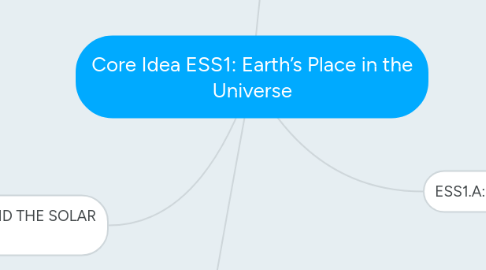
1. ESS1.B: EARTH AND THE SOLAR SYSTEM
1.1. The solar system consists of the sun and a collection of objects of varying sizes
1.1.1. Planets
1.1.1.1. Seasons
1.1.1.2. Ages
1.1.1.3. Ages
1.1.1.4. Ages
1.1.2. Moons
1.1.2.1. Phases
1.2. Gravity
1.2.1. Gravity holds Earth in orbit around the sun, and it holds the moon in orbit around Earth. The pulls of gravity from the sun and the moon cause the patterns of ocean tides.
1.2.2. On Earth the gravitational pull between Earth and Sun causes changes in tides
1.3. Predictable patterns of movement (Orbits)
1.4. Other phenomena
1.4.1. Gradual changes in the shape of Earth’s orbit around the sun (over hundreds of thousands of years), together with the tilt of the planet’s spin axis (or axis of rotation), have altered the intensity and distribution of sunlight falling on Earth.
1.5. Grade Endpoints
1.5.1. By the end of grade 2
1.5.1.1. Seasonal patterns of sunrise and sunset can be
1.5.1.1.1. observed
1.5.1.1.2. described
1.5.1.1.3. predicted
1.5.2. By the end of grade 5
1.5.2.1. Earth's orbit and rotation can give us observable patterns
1.5.2.1.1. Night
1.5.2.1.2. Day
1.5.2.1.3. Seasons
1.5.2.1.4. Phases of the moon
1.5.2.1.5. Different positions
1.5.2.1.6. Some planets can be seen with naked eye, others can't depending on phase, distance, and position
1.5.2.1.7. Stars appear as patterns called constellations
1.5.3. By the end of grade 8
1.5.3.1. The solar system consists of
1.5.3.1.1. The Sun
1.5.3.1.2. Planets
1.5.3.1.3. Moon
1.5.3.1.4. Asteroids
1.5.3.1.5. Stars
1.5.3.2. All items held together in orbit and with gravity
1.5.3.3. Seasons are caused by the tilt of the Earth's axis and differential intensity of sunlight
1.5.4. By the end of grade 12
1.5.4.1. Kepler's Laws
1.5.4.1.1. common features of the motions of orbiting objects
1.5.4.1.2. Earth's orbit and rotation can give us observable patterns
2. ESS1.C: THE HISTORY OF PLANET EARTH
2.1. Earth scientists use the structure, sequence, and properties of rocks, sediments, and fossils, as well as the locations of current and past ocean basins, lakes, and rivers, to reconstruct events in Earth’s planetary history.
2.2. Analyses of rock formations and the fossil record are used to establish rela- tive ages.
2.3. Grade Endpoints
2.3.1. By the end of grade 2
2.3.2. By the end of grade 5
2.3.2.1. Earth changes over time.
2.3.2.2. Some events on Earth occur in cycles, like day and night, and others have a beginning and an end, like a volcanic eruption.
2.3.2.3. Understanding how land- forms develop, are weathered (broken down into smaller pieces), and erode (get transported elsewhere) can help infer the history of the current landscape
2.3.2.3.1. Fossils
2.3.2.3.2. Tree rings
2.3.2.3.3. Rock formations, layers, and sediment
2.3.2.3.4. Ice cores from glaciers
2.3.3. By the end of grade 8
2.3.3.1. The geological time scale interpreted from rock strata provides a way to organize Earth’s history.
2.3.3.2. Analyses of rock strata and the fossil record provide only relative dates, not an absolute scale.
2.3.4. By the end of grade 12
2.3.4.1. Radioactive decay lifetimes and isotopic content in rocks provide a way of dating rock formations and thereby fixing the scale of geological time.
2.3.4.2. Plate Tectonics (Link to ESS2.B)
2.3.4.3. Erosion
3. ESS1.A: The Universe and Its Stars
3.1. The Sun is one of the stars in The Milky Way Galaxy
3.2. The Earth is a member of The Milky Way Galaxy
3.3. The Milky Way Galaxy has
3.3.1. Planets
3.3.2. Stars
3.3.3. Asteriods
3.4. Theories on how The Universe Began
3.4.1. Big Bang
3.5. Developmental stage of a star
3.5.1. Formation
3.5.2. Evolution
3.5.3. Supernova
3.6. Grade Endpoints
3.6.1. By the end of grade 2
3.6.1.1. Patterns of stars, planets, and the sun can be
3.6.1.1.1. observed
3.6.1.1.2. described
3.6.1.1.3. predicted
3.6.2. By the end of grade 5
3.6.2.1. Distances
3.6.2.1.1. Stars that are appear larger are closer and smaller are farther away
3.6.3. By the end of grade 8
3.6.3.1. Patterns
3.6.3.1.1. motion of the sun, the moon, and stars in the sky can be observed, described, predicted, and explained with models
3.6.3.2. Theories
3.6.3.2.1. Big Bang
3.6.3.3. Earth and the solar system are a part of the Milky Way Galaxy
3.6.4. By the end of grade 12
3.6.4.1. Distances/Brightness
3.6.4.1.1. Stars that are appear larger are closer and smaller are farther away (Brightness)
3.6.4.2. There are 200 billion stars in our galaxy
3.6.4.3. The Sun is changing and will burn out over a life span of approximately 10 billion years.

